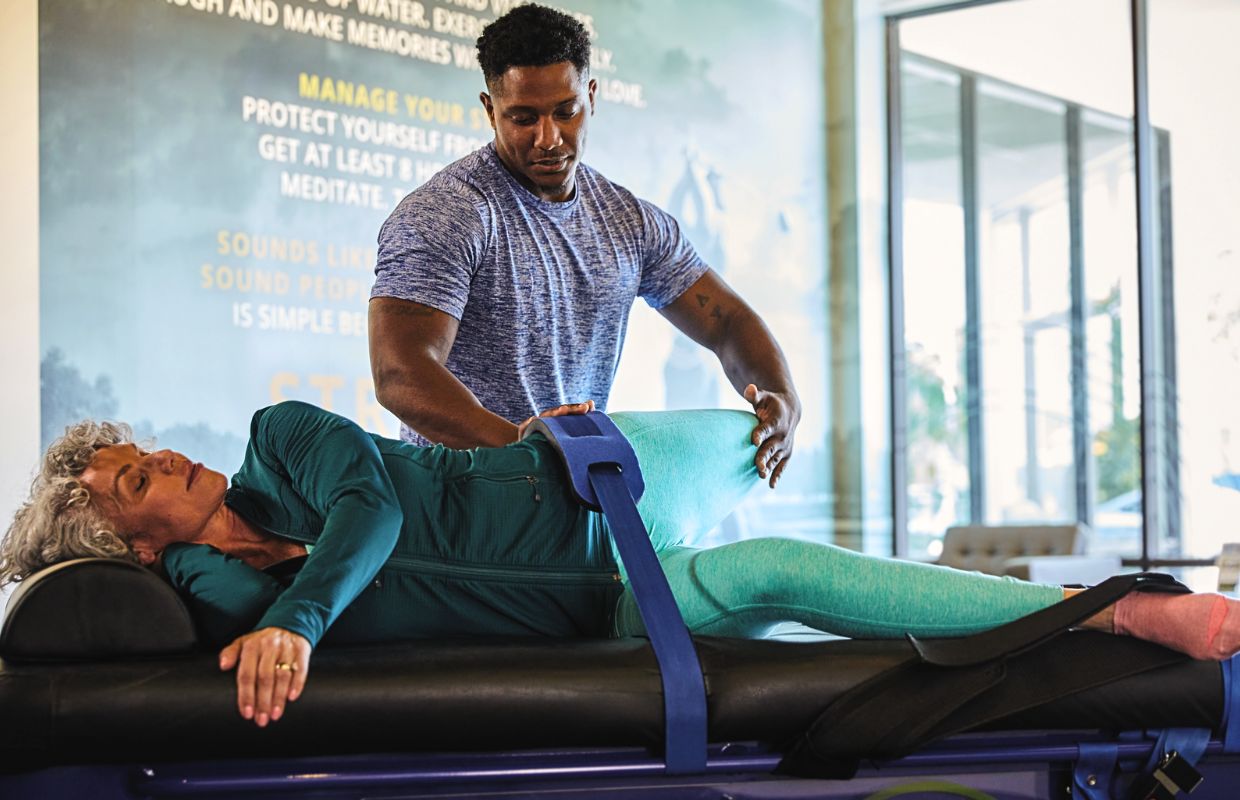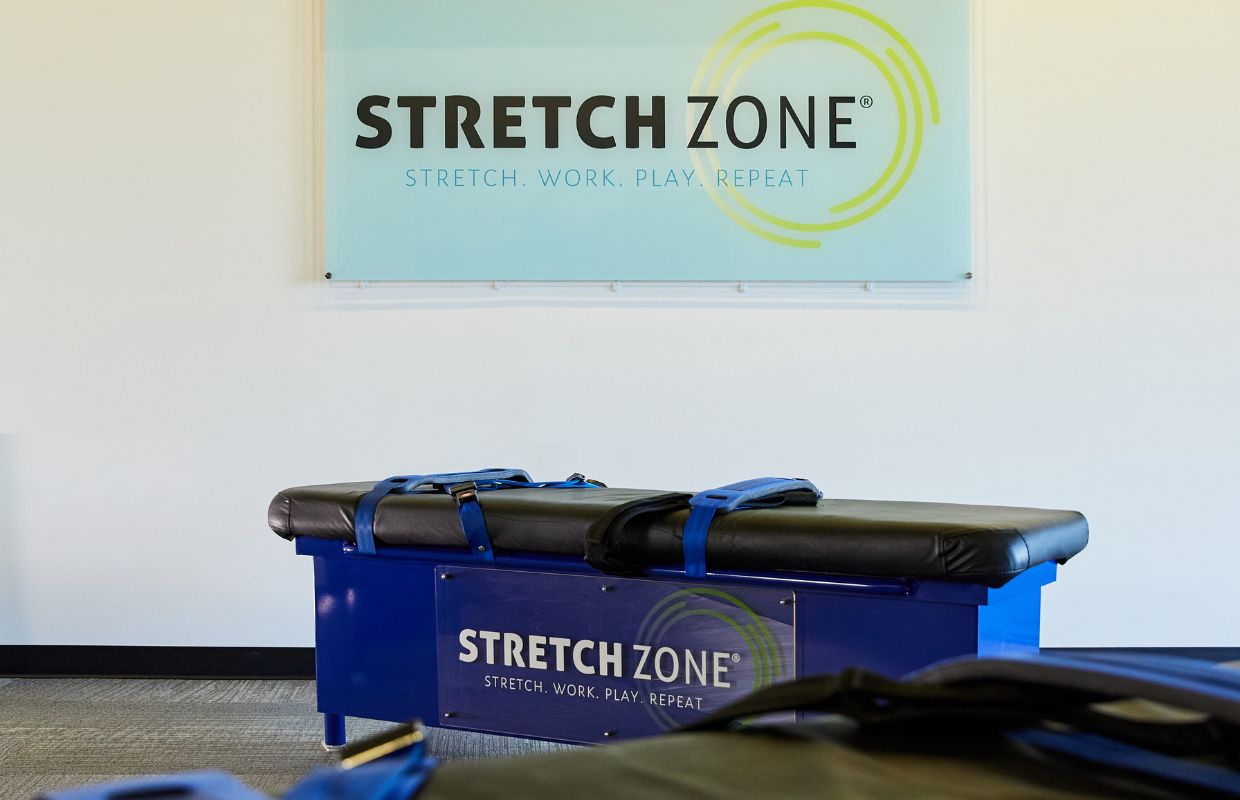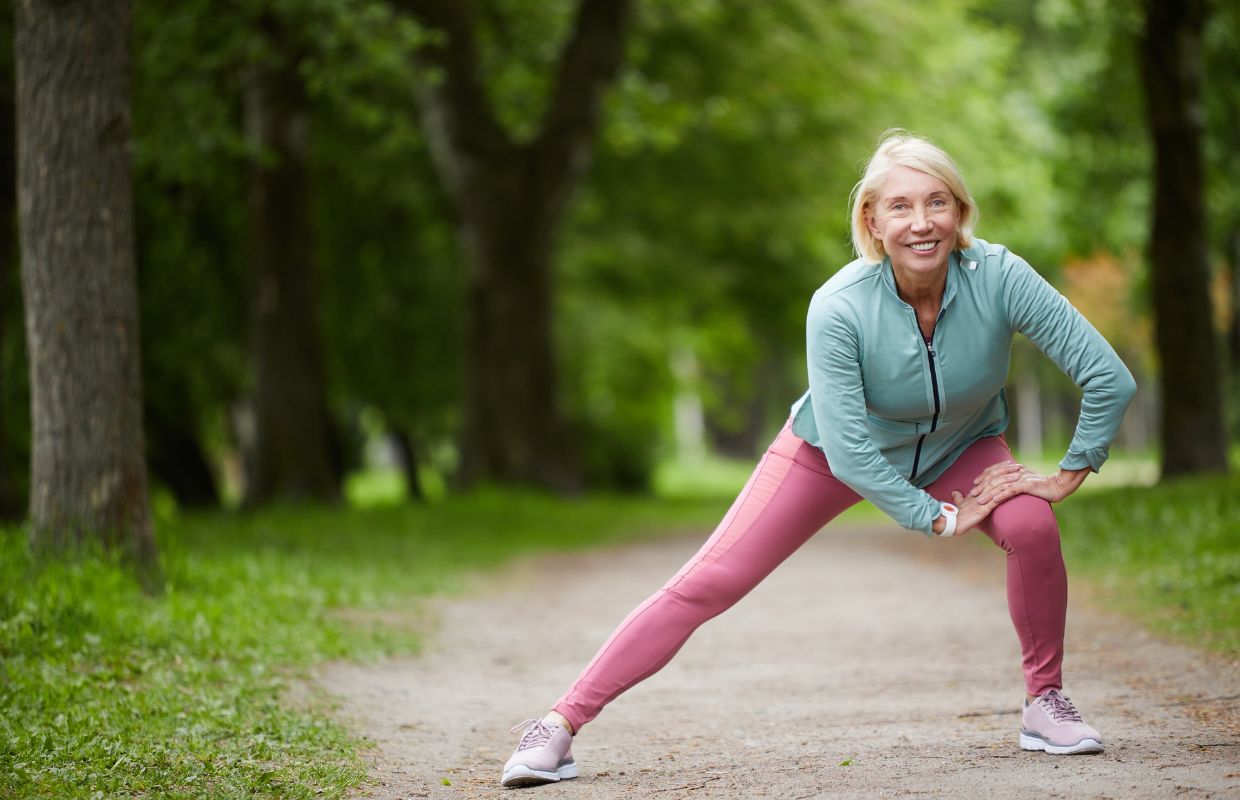
The Ultimate Guide to Stretching for Seniors
As we progress through life, our bodies undergo physiological changes, from the peak of youth to the golden years. Wherever you are in life, it’s crucial to take proactive measures to counter the effects of aging. One invaluable tool that can make a significant difference is stretching!
By embracing the transformative power of stretching, seniors can maintain their mobility, manage chronic conditions, and enhance their overall well-being. Regular stretching and upper back stretches can greatly enhance the physical and mental well-being of those approaching old age, offering them a means to combat the challenges that accompany the aging process.
This article outlines the physical and mental benefits of stretching for the aging body, how you can incorporate stretching into your daily routine, and general tips from our health experts about staying healthy while we grow old.
Understanding the Aging Process
Changes in the Aging Body
As we age, our bodies naturally undergo various changes that can affect our physical capabilities and overall well-being. Two key areas commonly affected are flexibility and muscle strength.
Over time, our flexibility tends to decrease, making it more challenging to move and easily perform everyday activities. Additionally, our muscle strength gradually diminishes, which can result in reduced mobility and overall physical performance.
Explore more about how the aging process impacts flexibility.
Common Age-Related Issues
In addition to decreased flexibility and muscle strength, we often experience other issues that can impact our daily lives as we get older. Joint stiffness is a common complaint, making it harder to bend, reach, or perform tasks requiring a full range of motion. This stiffness can be particularly noticeable in areas such as the knees, hips, and shoulders.
Another concern is the loss of balance and coordination. Our ability to maintain stability and control our movements can be compromised. This can increase the risk of falls and accidents, leading to potential injuries and a loss of confidence in one’s physical abilities.
Impact of Sedentary Lifestyle
Unfortunately, the modern sedentary lifestyle exacerbates the challenges faced by everyone, not just the elderly. Spending extended periods sitting or engaging in minimal physical activity can accelerate the decline of flexibility, muscle strength, and overall physical health. Lack of regular movement and exercise can also contribute to weight gain, muscle loss, and decreased cardiovascular fitness.
Moreover, a sedentary lifestyle can negatively impact mental well-being. It can lead to increased feelings of lethargy, decreased motivation, and a higher risk of mental health conditions such as depression and anxiety. The combination of physical and mental effects can create a cycle of decline that further hinders an aging individual’s quality of life.
Benefits of Stretching for the Aging Body
Incorporating regular stretching exercises such as upper back stretches into our daily routines can bring numerous benefits to the body. Stretching not only improves flexibility and range of motion but also increases muscle strength, enhances balance and coordination, and reduces the risk of injuries and falls. Let’s explore these benefits in more detail:
Improved Flexibility and Range of Motion
Flexibility is key to maintaining an active and independent lifestyle as we age. By engaging in regular stretching exercises, you can enhance joint flexibility and ensure a full range of motion. This means you can move more freely and perform everyday activities without discomfort or restriction. Imagine reaching for objects on high shelves, bending down to tie your shoes, or simply enjoying a leisurely walk—all with ease and grace.
To improve flexibility, consider incorporating stretches that target major muscle groups such as the legs, back, shoulders, and neck. These stretches help alleviate tension, increase muscle elasticity, and promote joint mobility. You’ll reap the benefits of improved flexibility and range of motion by including leg, upper back, shoulder, and neck stretches in your routine.
Increased Muscle Strength and Tone
Maintaining and developing muscle strength is crucial for aging bodies. Strong muscles provide support, stability, and power, enabling you to perform daily activities more efficiently. Regularly engaging in stretching exercises will allow you to preserve and enhance muscle strength, helping you stay active and independent as you age.
Stretching exercises target specific muscle groups and contribute to overall muscle tone. They stimulate the muscles, improving blood circulation and promoting the growth of lean muscle tissue. Strong muscles make physical tasks easier and boost your metabolism, support better posture, and contribute to improved bone health.
Consider incorporating movements such as squats, lunges, and tricep stretches to increase muscle strength and tone. These exercises engage various muscle groups, including the legs, glutes, arms, and core, promoting overall strength and stability.
Enhanced Balance and Coordination
Maintaining good balance and coordination is essential for preventing falls and injuries. Regular stretching can play a vital role in improving these aspects of physical performance, enabling you to navigate daily activities with confidence and ease.
Stretching exercises focusing on balance and coordination can challenge the body’s equilibrium and help improve proprioception—the body’s spatial awareness. You can enhance your balance, stability, and body control by incorporating yoga poses, tai chi, or practicing single-leg stances. These exercises strengthen the muscles involved in balance and enhance the mind-body connection, fostering a greater sense of well-being.
Reduced Risk of Injuries and Falls
Preventing injuries and falls is one of the primary concerns as we age. Stretching is crucial for injury prevention, as it increases flexibility and strengthens our muscles. By maintaining flexibility in your muscles and joints, you can avoid strains and sprains often resulting from sudden movements or overexertion.
Additionally, regular stretching exercises improve muscle coordination, allowing you to react quickly and effectively to potential hazards. Enhancing balance and stability reduces the risk of falls and their associated injuries, promoting a safer and more confident lifestyle.
Stretching for Mind-Body Connection
Stretching not only provides physical benefits but also offers numerous mental advantages, helping to create a harmonious balance between the body and mind.
Mental Benefits of Stretching as We Age
Regular stretching exercises profoundly impact mental well-being, providing a sense of calm, focus, and clarity. Some of the key mental benefits of stretching for aging individuals include:
- Stress reduction: Stretching and physical activity promote the release of endorphins, also known as “feel-good” hormones, which help reduce stress and promote a positive mood.
- Improved mood: Engaging in stretching routines can lift your spirits, reduce anxiety, and alleviate symptoms of depression. It is a natural way to boost your overall mood and emotional well-being.
- Enhanced cognitive function: Stretching increases blood flow to the brain, which can improve cognitive function, memory, and concentration. It helps keep your mind sharp and alert.
- Mindfulness and presence: Stretching requires focus and attention to the body’s sensations, fostering mindfulness and promoting a deeper connection between the mind and body.
Relaxation and Stress Reduction
Stretching, including upper back stretches, is a powerful tool for relaxation and stress reduction, providing a much-needed break from life’s daily pressures and demands. By incorporating stretching into your routine, you can experience the following benefits:
- Muscle relaxation: Stretching releases tension in the muscles, reducing feelings of tightness and promotes a state of relaxation.
- Improved sleep: Engaging in a stretching routine before bedtime can help relax the body and mind, facilitate better quality sleep and promote a sense of rejuvenation.
- Stress relief: Stretching allows you to focus on your body and the present moment, providing a mental escape from stressors and promoting a sense of calm.
The Link Between Physical and Mental Well-being
Recognizing the strong connection between physical and mental well-being is important, especially as we age. Taking care of your physical health through stretching and upper back stretches can positively impact your mental state and overall quality of life. Here are some key aspects of this link:
- Increased self-confidence: Regular stretching helps improve physical performance, mobility, and posture, leading to increased self-confidence and a more positive self-image.
- Sense of accomplishment: Setting stretching goals and achieving them can boost self-esteem and create a sense of accomplishment, further enhancing overall well-being.
How to Incorporate Stretching into Your Daily Routine
Stretching can be easily integrated into your daily routine, helping you reap numerous benefits. Whether you’re new to stretching or looking to enhance your existing performance, here are some tips to guide you on your stretching journey:
Starting a Stretching Routine
- Begin gradually: For example, if you start with upper back stretches, try to be gentle and gradually increase the intensity over time. This allows your body to adapt and prevents potential muscle soreness or injury.
- Warm up first: Before stretching, engage in a brief warm-up activity, such as a brisk walk or light cardio exercises, to increase blood flow and prepare your muscles for stretching.
- Find a comfortable space: Choose a quiet and peaceful environment where you can focus on your stretching routine without distractions.
Frequency of Stretching Sessions
- Consistency is key: Aim for at least 2-3 weekly stretching sessions to maintain flexibility and reap the benefits of stretching. However, daily stretching is even more beneficial for most individuals.
- Adjust according to your needs: Pay attention to how your body feels during and after stretching. If a particular stretch feels uncomfortable or causes discomfort, modify it or seek guidance from a qualified professional.
Try Practitioner-Assisted Stretching
Consider incorporating practitioner-assisted stretching into your routine for optimal benefits. Here are some advantages:
- Enhanced stretching depth: With the guidance of a professional, you can achieve deeper stretches and target specific muscle groups more effectively.
- Improved posture and alignment: Practitioner-assisted stretching helps address postural imbalances and alignment issues, promoting better posture and overall body mechanics.
- Personalized approach: The stretch practitioner can tailor the stretching program to your individual needs, addressing specific areas of concern.
- Injury prevention and recovery: Practitioner-assisted stretching can help prevent injuries by identifying and addressing areas of tightness or weakness. It can also aid in the rehabilitation and recovery process from existing injuries.
Additional Strategies for Healthy Aging
In addition to incorporating stretching and upper back stretches into your daily routine, several other strategies can contribute to healthy aging. Adopting these practices can further enhance your overall well-being and promote a vibrant and active lifestyle.
Regular Exercise and Balanced Diet
Regular Exercise
Engaging in physical activity is vital for maintaining overall health and vitality. Choose activities you enjoy, such as walking, swimming, or cycling, and aim for at least 150 minutes of moderate-intensity exercise per week. Exercise helps improve cardiovascular health, maintain muscle strength, and enhance flexibility.
Balanced Diet
Nourishing your body with a well-rounded and nutritious diet is essential. Include a variety of fruits, vegetables, whole grains, lean proteins, and healthy fats in your meals. Prioritize nutrient-dense foods that provide vitamins, minerals, and antioxidants to support your body’s needs as you age.
Maintain a Strong Posture
Postural Exercises
Engage in exercises that specifically target the muscles responsible for good posture. These exercises help improve muscle strength, alleviate back pain, enhance balance, and reduce the risk of falls. Examples of postural exercises include shoulder blade squeezes, planks, and bridge poses.
Mindful Body Awareness
Develop an increased awareness of your posture throughout the day. Take breaks from prolonged sitting or standing, stretch your body, and adjust your posture regularly. Mindful body awareness exercises, such as yoga or tai chi, can also help improve your posture and balance.
Ergonomic Adjustments
Make ergonomic adjustments to your environment to support good posture and reduce strain on your body. Use proper seating that provides adequate support for your back. Adjust your computer screen to eye level to prevent straining your neck. Maintain good posture while sitting and standing, distributing your weight evenly and keeping your spine aligned.
Importance of Staying Hydrated and Getting Enough Sleep
Staying Hydrated
Adequate hydration is essential for maintaining overall health, especially as we age. Drink plenty of water throughout the day to support bodily functions, promote healthy digestion, and keep your joints lubricated. Pay attention to your body’s thirst signals and aim to consume around eight glasses of water daily.
Getting Enough Sleep
Quality sleep is crucial for your physical and mental well-being. Aim for 7-9 hours of sleep each night to allow your body to rest, repair, and rejuvenate. Establish a regular sleep routine, create a comfortable sleep environment, and practice relaxation techniques before bedtime to promote restful sleep.
Ready to Turn Back the Clock with Upper Back Stretches?
Graceful aging is possible, and it doesn’t have to be accompanied by discomfort and aching. Embrace the power of stretching, prioritize your well-being, and take proactive steps toward a vibrant and fulfilling life. Contact Stretch Zone to discover how we can assist you in achieving a more comfortable and active lifestyle as you age gracefully.
Schedule your free session today!


